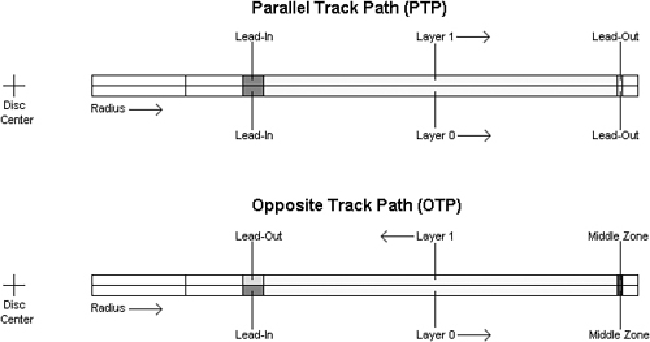Hardware Reference
In-Depth Information
Note that although
Figure 11.11
shows two lasers reading the bottom of the dual-layer
discs, in actual practice only one laser is used. Only the focus is changed to read the dif-
ferent layers.
Dual-layer discs can have the layers recorded in two ways: either opposite track path
(OTP) or parallel track path (PTP). OTP minimizes the time needed to switch from one
layer to the other when reading the disc. When reaching the inside of the disc (end of
Layer 0), the laser pickup remains in the same location—it merely moves toward the disc
slightly to focus on Layer 1. When written in OTP mode, the lead-out zone toward the
outer part of the disc is called a middle zone. Discs written in PTP have both spiral layers
written(andread)fromtheinsideout.WhenchangingfromLayer0toLayer1,PTPdiscs
require the laser pickup tomove fromthe outside (endofthe first layer) back tothe inside
(startofthesecondlayer),aswellasforthefocusofthelasertochange.Virtuallyalldiscs
are written in OTP mode to make the layer change quicker. OTP recording is also used by
dual-layer (DL) DVD rewritable drives.
To allow the layers to be read more easily even though they are on top of one another,
discs written in PTP mode have the spiral direction changed from one layer to the other.
Layer0hasaspiralwindingclockwise(whichisreadcounterclockwise),whereasLayer1
has a spiral winding counterclockwise. This typically requires that the drive spin the disc
intheoppositedirectiontoreadthatlayer,butwithOTPthespiralisreadfromtheoutside
inonthesecondlayer.SoLayer0spiralsfromtheinsideout,andLayer1spiralsfromthe
outside in.
Figure 11.12
shows the differences between PTP and OTP on a DVD.
Figure 11.12
PTP versus OTP.

